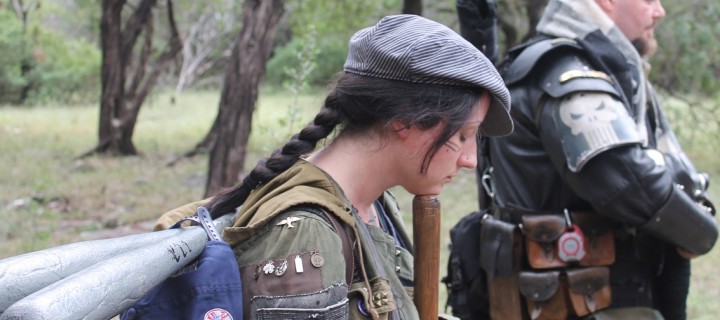Participants often engage in role-playing in order to step inside the shoes of another person in a fictional reality that they consider “consequence-free.” However, role-players sometimes experience moments where their real life feelings, thoughts, relationships, and physical states spill over into their characters’ and vice versa. In role-playing studies, we call this phenomenon bleed.[1]Markus Montola, “The Positive Negative Experience in Extreme Role-playing.” Proceedings of DiGRA Nordic 2010: Experiencing Games: Games, Play, and Players, 2010; Sarah Lynne Bowman, “Social Conflict in Role-playing Communities: An Exploratory Qualitative Study,” International Journal of Role-Playing 4, 2013, pp.17-18.
Bleed is neither inherently negative nor positive. Some players erect strong mental boundaries between themselves and their characters in order to avoid bleed. Others consciously seek bleed experiences by “playing close to home.”[2]Jeepform Dictionary, “Bleed,” Jeepen.org. Similarly, some games are designed with the intention of drawing people as far outside of their normal lives as possible through fantastic elements or improbable circumstances. Others are built with the specific goal of inducing a strong emotional reaction in the players and encouraging them to contemplate how the fiction relates to their own lives.
Bleed: How Emotions Affect Role-Playing Experiences – Sarah Lynne Bowman
Regardless of player or designer motivations, sometimes bleed occurs without prompting. These experiences can often come as a surprise, especially when the players are unprepared and have no tools for how to discuss about or manage bleed. This article will explain the phenomenon from a theoretical perspective, detail some of the types of bleed, examine the debates surrounding the concept, and suggest some strategies for managing bleed experiences.
The Phenomenon of Bleed
Explaining the phenomenon of bleed first requires establishing some basic vocabulary to help understand the role-playing experience as a whole. First, when we enter the game from the outside, we adopt a new set of social rules, both implicit and explicit.[3]Markus Montola, “Social Reality in Role-playing Games,” in The Foundation Stone of Nordic Larp, edited by Eleanor Saitta, Marie Holm-Andersen, and Jon Back (Toptryk Grafisk, Denmark: Knutpunkt, 2014), 103-112. These social rules function on an in-character level, e.g., this former warship is actually a spaceship; when a character throws a packet, it symbolizes a fireball; when a player speaks, they are portraying a noblewoman, not their real world profession; etc. Out-of-game social rules also apply, e.g., we will stay in-character for the duration of the experience; we will avoid touching without permission; we will observe safe words when used; etc. Collectively, these rules make up the social contract of the game.[4]Shoshana Kessock, “Ethical Content Management and the Gaming Social Contract,” in The Wyrd Con Companion Book 2013, edited by Sarah Lynne Bowman and Aaron Vanek (Los Angeles, CA: Wyrd Con), 102-111. When the social contract is established, players can enter safety the magic circle, a poetic term describing the rules, identities, and occurrences within the game space.[5]Johan Huizinga, Homo Ludens: A Study of the Play-Element in Culture (Boston, MA: Beacon Press, 1958); Katie Salen and Eric Zimmerman, Rules of Play: Game Design Fundamentals (Cambridge, MA: MIT Press, 2004); Markus Montola, On the Edge of the Magic Circle. Understanding Role-Playing and Pervasive Games, Doctoral Dissertation (Tampere, Finland: Tampere University Press, 2012).

Diagram of role-playing studies terminology, including the relationship between bleed and alibi. Image by Mat Auryn. Design by Sarah Lynne Bowman.
Perhaps the most important facet of the social contract is the alibi, in which players accept the premise that any actions in the game are taken by the character, not by the player.[6]Markus Montola and Jussi Holopainen, “First Person Audience and Painful Role-playing,” in Immersive Gameplay, edited by Evan Torner and William J. White (Jefferson, NC: McFarland, 2012). Phrases like, “It wasn’t me, it was my character” and “It’s what my character would have done” are a direct result of the benefit of alibi. In principle, no individual is responsible for their actions in-character if those events could unfold plausibly within the fiction.
Alibi has a direct correlation with bleed: the stronger the alibi, the weaker the bleed. Alternately, playing close to home provides an inherently weaker alibi. For example, if a player has children in real life, playing a parent in a game will likely produce greater bleed and lesser alibi. The player might strengthen the alibi by establishing very different relationship dynamics between the character and the fictional children, thereby affording added distance. Alternately, the player can choose to push toward a greater degree of bleed by using the real names of his or her real life children in-game.
None of these choices will ensure the participant will experience greater or lesser bleed, however. Bleed is not a factor players can necessarily control. In fact, bleed is largely an unconscious process when it occurs, whereas a conscious choice on the part of the player to alter the course of the character is known as steering.[7]Markus Montola, Jaakko Stenros, and Eleanor Saitta, “The Art of Steering: Bringing the Player and the Character Back Together,” in The Knudepunkt 2015 Companion Book, edited by Charles Bo Nielsen and Claus Raasted (Copenhagen, Denmark: Rollespilsakademiet, 2015), 10-117. Therefore, a player can steer toward greater bleed by pushing factors that are likely to cause a bleed response, but bleed is not guaranteed.[8]Mike Pohjola, “Steering for Immersion in Five Nordic Larps: A New Understanding of Eläytyminen,” in The Knudepunkt 2015 Companion Book, edited by Charles Bo Nielsen and Claus Raasted (Copenhagen, Denmark: Rollespilsakademiet, 2015), 10-117. Alternately, players can steer away from potentially emotionally impacting factors, but end up affected by them nonetheless.

A character at the post-apocalyptic game Dystopia Rising: Lone Star in Texas mourns the death of his in-game wife, an event that took months to emotionally process. (Play, Sarah Lynne Bowman)

Characters at DR Lone Star comfort someone after she finds out her in-game family member just died. All photos by Sarah Lynne Bowman. (Play, Sarah Lynne Bowman)
Types of Bleed
Bleed comes in two major forms: bleed-in – when the emotions, thoughts, relationship dynamics, and physical states of the player affect the character – and bleed-out, the opposite process.[9]Montola, “Positive Negative”; Bowman, “Social Conflict.” A bleed feedback loop is also observable, when it becomes difficult to tell where the player begins and the character ends, especially in emotionally overwhelming situations. For example, in games where players experience sleep deprivation and constant attacks from enemies, the exhausted mind may have difficulty distinguishing between a “fake” attack and a “real” one. This phenomenon does not mean that the player is incapable of upholding the magic circle, but rather that the intensity of emotion has become overwhelming to the mind, causing confusion and difficulties with immediate processing and distancing.
Bleed is most often described in terms of emotional experiences, as emotions are the least conscious and most spontaneous aspects of enactment. However, other factors are connected with emotional reactions. Out-of-game thoughts are often interwoven with emotional responses, e.g. “I can’t believe Johnny is insulting my character. He always acts this way when we play together,” which may later induce an angry outburst in-character. Also, relationship dynamics can affect bleed. If two players are best friends out-of-game, they may unconsciously replicate that dynamic within the magic circle.
Physical states can also produce bleed, especially sleep deprivation or exhaustion, which weaken the mental defenses of the players and makes them more susceptible to impulsive emotional responses. Many games, such as high-immersion combat larps, are built upon this principle, though the designers may not realize that they are creating a game designed to produce a bleed effect.
Another type of bleed is termed ego bleed by Whitney “Strix” Beltrán.[10]Whitney “Strix” Beltran, “Yearning for the Hero Within: Live Action Role-Playing as Engagement with Mythical Archetypes,” in Wyrd Con Companion 2012, edited by Sarah Lynne Bowman and Aaron Vanek (Los Angeles, CA: Wyrd Con, 2012), 91-98. Ego bleed occurs when the contents of the player’s personality spillover into the character’s and vice versa. This effect is most measurable when players claim to have learned skills from their in-game experiences that become useful in reality, such as leadership, seduction, etc. However, prolonged immersion into antisocial characteristics such as violent plotting and social backstabbing may impact negatively the participants’ personalities, affecting their relationships with other players out-of-game.[11]Whitney “Strix” Beltran, “Shadow Work: A Jungian Perspective on the Underside of Live Action Role-Play in the United States,” in The Wyrd Con Companion Book 2013, edited by Sarah Lynne Bowman and Aaron Vanek (Los Angeles, CA: Wyrd Con, 2013), 94-101. This issue is particularly problematic in campaign play, where long-term immersion into a particular character or fiction without distinct stopping points can produce what Gary Alan Fine calls overinvolvement, a phenomenon in which the players do not sufficiently shed the role and fail to fully reintegrate into their mundane lives.[12]Gary Alan Fine, Shared Fantasy: Role-playing Games as Social Worlds (Chicago, IL: University of Chicago Press, 1983).
At its most positive, bleed experiences can produce moments of catharsis: when the player and character emotions are synced in a powerful moment of emotional expression. Most often, these experiences manifest in great displays of joy, love, anger, or grief; in-game crying is often associated with bleed.[13]Sarah Lynne Bowman, “Bleed: How Emotions Affect Role-playing Experiences,” Nordic Larp Talks Oslo, 2013. Regardless of their original intentions for alibi, players often call these cathartic experiences their Golden Moments, perhaps because the alibi of the game is still strong enough to allow them the opportunity to express emotions they might otherwise feel inhibited to share in real life.

A character in DR Lone Star experiences a cathartic moment, crying for the death of his mother during his baptism scene into a new religion. (Play, Sarah Lynne Bowman)

Other characters comfort him, letting him know he has friends and is not alone. In-character support can help lessen the negative impact of bleed. (Play, Sarah Lynne Bowman)
However, not all bleed experiences are considered positive.[14]Bowman, “Social Conflict” Players may, for example, feel lasting aggression toward someone who acted antagonistically toward their character in-game. Such feelings may do damage to their out-of-game relationships. Intimate love connections can also form in games as the result of bleed. While some of these relationships may translate well to the outside world, with happy couples forming as a result, in-game relationships also run the risk of damaging existing intimate bonds by complicating established boundaries or invoking jealousy.[15]Gordon Olmstead-Dean, “Impact of Relationships on Games,” in Lifelike, edited by Jesper Donnis, Morten Gade and Line Thorup (Copenhagen: Projektgruppen KP07, 2007), 195-210; Bowman, “Social Conflict.”

In-game wedding at DR Lone Star after a year of in-character courtship. The characters are romantically involved, but the players are not. (Play, Sarah Lynne Bowman)

In-game wedding at DR Lone Star after a year of in-character courtship. The characters are romantically involved, but the players are not. (Play, Sarah Lynne Bowman)
Finally, distinguishing between bleed and psychological triggers is important. As Maury Brown explains, psychological triggers in role-playing occur when some sort of stimuli activates a previous traumatic memory and induces a response.[16]Maury Brown, “Pulling the Trigger on Player Agency: How Psychological Intrusion in Larps Affect Game Play,” in The Wyrd Con Companion Book 2014, edited by Sarah Lynne Bowman (Los Angeles, CA: Wyrd Con), 96-111. Trigger responses can range from mild to severe. While triggers are a form of bleed-in, as they represent aspects of the player’s psychology affecting the character experience, not all bleed moments are “triggers.” Safety precautions such as in-game signaling and safe words can help community members distinguish between a player having a cathartic bleed moment and reliving the disruptive triggering of previous trauma.
Debates Surrounding Bleed
Some role-playing communities consider bleed a taboo subject. Because of the so-called Satanic Panic[17]Stark, Lizzie. Leaving Mundania: Inside the Transformative World of Live Action Role-playing Games. Chicago, IL: Chicago Review Press, 2012. and other alarmist outside perceptions of the dangers of role-playing – e.g., Mazes and Monsters, The Wild Hunt, Knights of Badassdom – many participants have endured decades of stigma. Fears around role-playing center upon the assumption that immersion into another person and fictional world will make the individual lose touch with reality and forget who they are. On the extreme end, religious conservatives fear that role-players will become involved in the occult and start using magic “for real” (see the Chick Tracts, recently dramatized in the film Dark Dungeons).
Therefore, role-players are extremely sensitive to these allegations and often wish to distance themselves as much as possible from the perception of becoming “too close” to the character. Individuals who experience bleed and suffer negative consequences, such as players who feel long-term grief as the result of losing a character, might get shamed or otherwise ostracized from certain gaming groups. Some role-players refuse to admit that bleed exists and become defensive at the concept itself, wishing to reinforce the alibi at all costs. Often, these individuals do not wish to be held personally responsible for anything that their character does in-game, which is understandable. However, an airtight alibi can promote a dismissive attitude toward communal problems such as in-game bullying by individuals and cliques. Denying that participants can become personally impacted by game events erases the experience of many players and silences their ability to ask for help.
Ultimately, I believe that denying the existence of the real phenomenon of bleed is not an effective strategy to manage it in role-playing communities. Instead, I suggest that groups adopt a common terminology and a set of techniques to help people experience greater emotional depths in-character and return back to their lives with minimal negative impact.
Strategies to Manage Bleed
Whether or not participants intend to play for bleed, the impact of bleed experiences can become quite intense for some individuals. Players with a strong distance between self and character may find themselves mystified when another participant feels long-lasting emotional devastation at the loss of an in-game companion, for example. I believe that we should acknowledge that the perspectives of both of these types of players are valid: those who experience strong bleed and those who do not. Furthermore, as a community, we can learn strategies to help individuals recover who feel emotionally overwhelmed or confused after a game is done.[18]Johanna Koljonen, Peter Munthe-Kaas, Bjarke Pedersen, and Jaakko Stenros, “The Great Player Safety Controversy,” Panel at Solmukohta 2012, Nurmijärvi, Finland, April 13, 2012; Johanna Koljonen, “The Second Great Player Safety Controversy,” Presentation at Knutepunkt 2013, Haraldvangen, Norway, April 19, 2013; Johanna Koljonen, “Safety in Larp,” Presentation at the Larpwriter Summer School 2013, Vilnius, Lithuania, last modified Aug. 1, 2013, YouTube, Fantasiforbundet, https://www.youtube.com/watch?v=Qho9O_EMG34; Johanna Koljonen, “Emotional and Physical Safety in Larp – Larpwriter Summer School 2014,” Presentation at the Larpwriter Summer School 2014, Vilnius, Lithuania, last modified Aug. 3, 2014, YouTube, Fantasiforbundet, https://www.youtube.com/watch?v=g-cPmM2bDcU.
One such strategy is called in-game signaling. During role-playing, in-game signaling techniques help players communicate to one another if bleed has become too intense. Games may employ hand gestures, safe words, “okay” symbols, written check marks, or other methods that enable players to indicate to one another whether or not they are overwhelmed or in need of a break. In order for these signals to be effective, the organizers and role-playing community must reinforce and encourage their use. In other words, players should feel safe to opt-out of a scene at any time and should not feel pressured to continue in order to avoid “ruining” the game for others.

At a briefing before the Planetfall larp in Austin, Texas, organizers explain how to signal backing away from a scene by placing a hand behind the neck. (Play, Sarah Lynne Bowman)

In DR Lone Star, an NPC player signals being off-game with a hand over her head and a whooshing sound, to be interpreted by characters as “the wind.” (Play, Sarah Lynne Bowman)
An important post-game strategy is creating rituals of de-roleing. De-roleing is a method by which the player ritually casts aside the role and re-enters their former identity. Some strategies for de-roleing include: players removing an article of their characters’ clothing and placing it before them in the circle; participants stating what they want to take with them from the character and what they want to leave behind; organizers leading players through a guided meditation to ease their transition; etc. These symbolic actions allow players to switch from the frame of the character to the player in a manner that is less jarring than a hard stop.
Debriefing is another useful strategy to help players process their emotions. Creating a formal space after the game for players to express their feelings and share stories in a serious manner often helps contextualize bleed. Additionally, assigning a “debriefing buddy” provides players with a safety net for private communication after the larp with another participant. Positive, out-of-character communication with other players who were part of intense scenes may help alleviate lasting negative feelings, e.g. “I’m sorry that my character was so cruel to you in-game. Would you like to talk about it?” For a more extensive discussion on debriefing, refer to my article in this series, “Returning to the Real World.”[19]Sarah Lynne Bowman, “Returning to the Real World: Debriefing After Role-playing Games,” Nordiclarp.org, Dec. 8, 2014.
Informally, players also can engage in out-of-game socializing, such as dinners, afterparties, charity events, etc. These events help players feel connected to the community outside of the context of the fiction and their characters. Social events reinforce the co-creative nature of the role-playing experience and open up spaces for dialogue about the game, allowing for greater communication. Online forums and social media can also work toward this aim if used with the intention of building out-of-game community.
Some players find writing a useful strategy for managing bleed. Examples include journaling in- or out-of-character, writing a letter to one’s character, creating new stories around that persona, sharing written game memories with other participants, etc. Telling war stories to each other is another popular method of sharing. Externalizing the experiences in a linear fashion, whether verbally or on paper, seems to help immensely by allowing players the chance to reframe their story in a manageable way.
Further strategies include becoming immersed in other experiences. Some people can easily throw themselves into their work, while others have difficulty returning back to daily life. Often, the first 48 hours after a weekend-long game can prove difficult in terms of adjustment. Playing video games, another role-playing game, or immersing into another fictional reality like a television show can help ease this transition. Most importantly, adequate sleep, eating, and hygiene can help reset a player’s psychological state to some semblance of normality. For more information, see my article with Evan Torner on “Post-Larp Depression.”[20]Sarah Lynne Bowman and Evan Torner, “Post-Larp Depression,” Analog Game Studies 1, no. 1. (1 Aug 2014).
A Collective Experience
Regardless of the degree of immersion or bleed each player feels, ultimately the role-playing experience is a co-creative and collective one. Understanding bleed and developing tools for compassionately managing intense emotional reactions can help role-playing communities reach deeper levels of trust and collaboration. Recognizing that each individual contributes an important part to the whole is an important step in this process. A healthy community is made up of individuals who feel safe and able to openly communicate with one another about their experiences.
Cover photo: Characters at DR Lone Star attend an in-game funeral to mourn their lost friends. In-game ceremonies are one way of coping with strong emotions within the frame of the magic circle (Play, Sarah Lynne Bowman).
References






